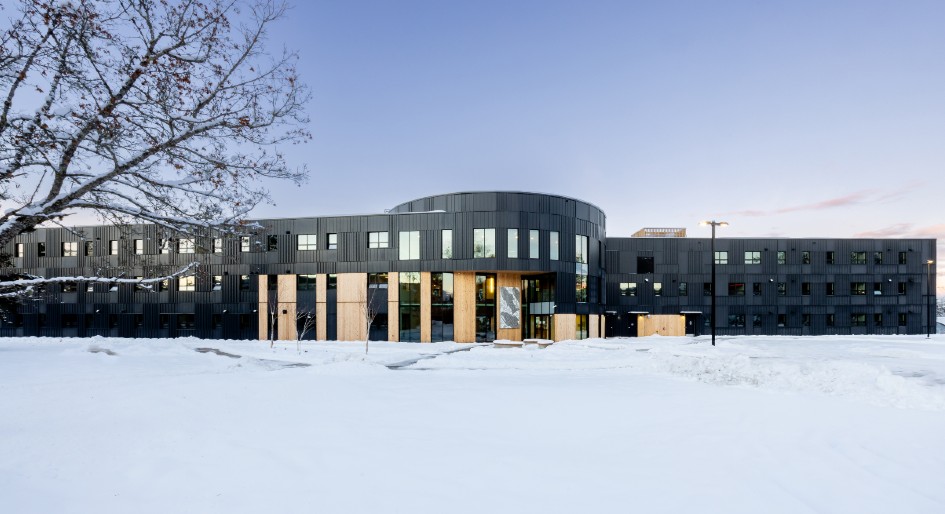Coast Mountain College students in Terrace, northwest British Columbia, have completed their first full academic year living in the Wii Gyemsiga Siwilaawksat Student Building, with accommodation expected to be at full capacity by September.
Following a $18.7-million investment from the British Columbia government, the three-storey building replaced 40-year-old-student housing that was no longer fit for purpose.
Since about 48 per cent of the student population is Indigenous, the facility was designed to empower Indigenous students to flourish in post-secondary education.
The campus sits on the traditional territory of the Tsimshian Kitsumkalum people, serving six different Nations – Haida, Haisla, Nisga’a, Wet’suwet’en, Gitxsan, Tsimshian, and 21 distinct First Nation communities.
Wii Gyemsiga Siwilaawksat translates from local First Nations language Sm’algyax into English as, “where learners are content and comfortable”. The College developed the original project brief using a decolonized, indigenized approach to engage and understand the needs of its communities.
Designed by hcma, Indigenous art, culture, language and ceremony experts informed the process, led by hcma, Principal-in-Charge Karen Marler and hcma Project Architect Aiden Callison, IDL Projects was the design build contractor on the project.
The building is made up of modular student housing units grouped around a purpose-built central atrium. Inside, it houses a large cultural space, 108 student beds, two hotel suites, an elder suite, six shared kitchens, two collaboration areas, a computer lab, an Esports room, a maker space, and bike storage.
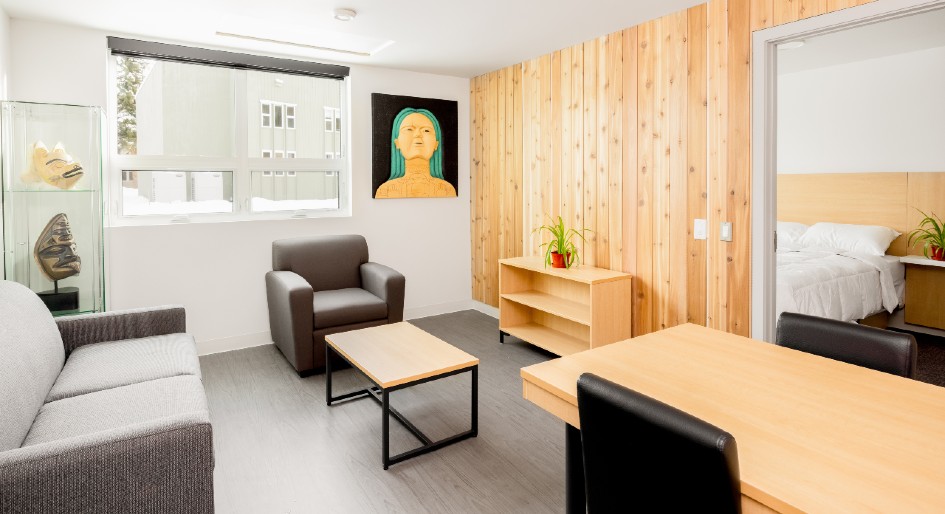
An elder’s suite. Photo by Bright Photography. Art: Sculptured panel by Nakkita Trimble, Nisga’a nation; Alder mask by Shawn Aster, Tsimshian nation; Bronze mask by Dempsey Bob, Tahltan/Tlingit nations.
Indigenous design principles that represent the Northwest Coast region and the First Nations communities the College are embedded throughout the building.
“Indigenization and decolonization creates informed and mutually respectful citizens,” says Callison. “It means better outcomes for everyone by delivering Indigenous ways of learning and culturally appropriate support, while also fostering cross-cultural learning for the broader student body.”
Sacred cedar
The old growth cedar tree is a symbol of the northwest coast. Used for shelter, clothing, transportation, ceremony, and spiritual beliefs, it’s been integral to local First Nations’ culture for thousands of years. It felt appropriate for this sacred material to inform the building’s expression.
For the exterior cladding, Tsimshian weaving patterns seamlessly unite the building’s two student housing wings, while mimicking the expression of cedar bark. Inside, a cedar-clad central lobby space — akin to a hollow cedar tree, or heartwood — hosts gatherings and ceremony.
Each of its three levels are connected by house posts, while a glulam pin-wheel structure—inspired by traditional Northwest Coast Indigenous architecture—honours each Nation the college serves, symbolizing connection, strength, and unity.
Integrating Indigenous art
To help students feel represented, over 70 different art installations were designed by Indigenous artists and are integrated throughout the building.
“Collaborating with local artists and designers has added a rich layer of storytelling to the space that roots the student housing in its community,” says Marler.
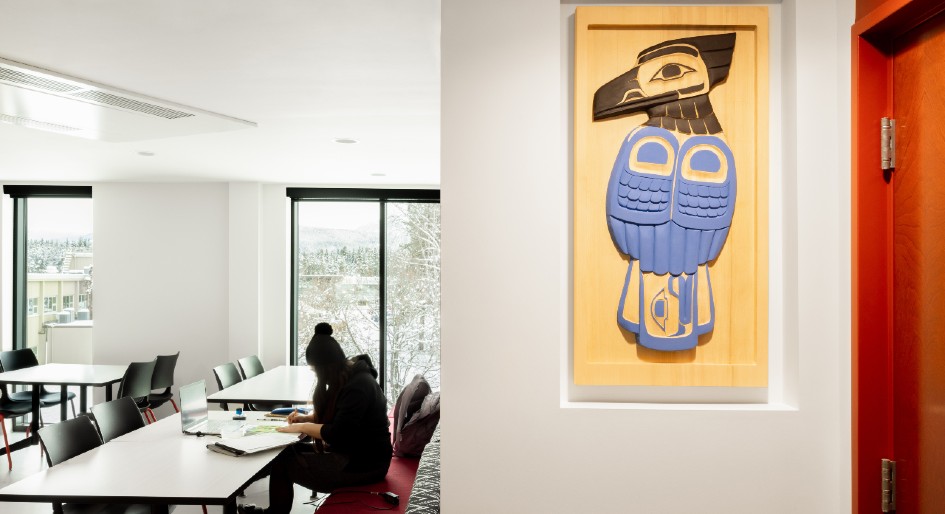
The entrance to Blue Jay wing. Photo by Bright Photography. Art: Gwisgwaas by Paula Wesley, Tsimshian nation.
They include master carvers and Coast Mountain College instructors, Stan Bevan and Ken McNeil, who led the procurement process and collaborated with students and alumni of the Freda Diesing School of Northwest Coast Art.
The central celebration space hosts eight, six-foot tall cedar house posts, each telling unique stories of the First Nations communities the school serves, while each student housing floor has a theme that represents their distinct cultures expressed through artwork and carved cedar panels.
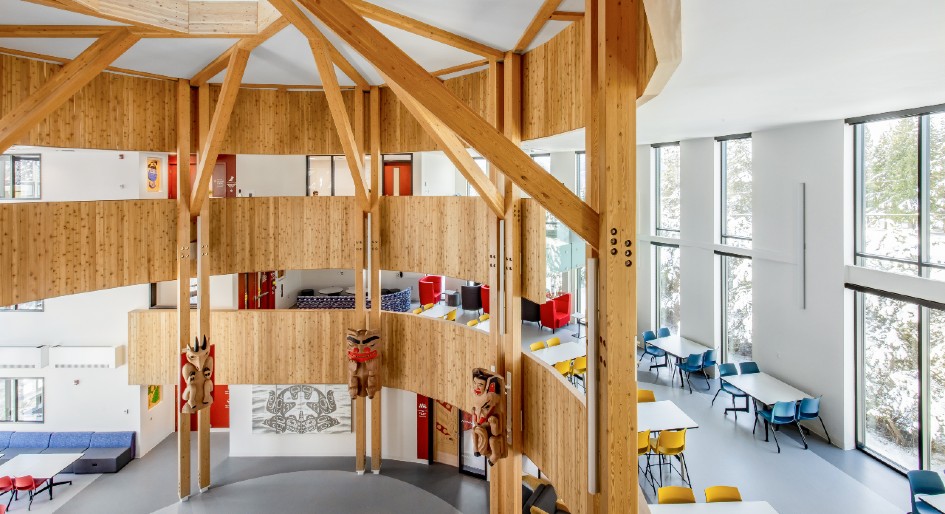
Central celebration space study areas. Photo by Bright Photography. Art: Beaver by Arlene Ness, Gitxsan nation; Raven by Stan Bevan, Tsimshian/Talhtan nations; Goat by Nathan Wilson, Haisla nation; and Bear by Ken McNeil, Nisga’a/Talhtan nations.
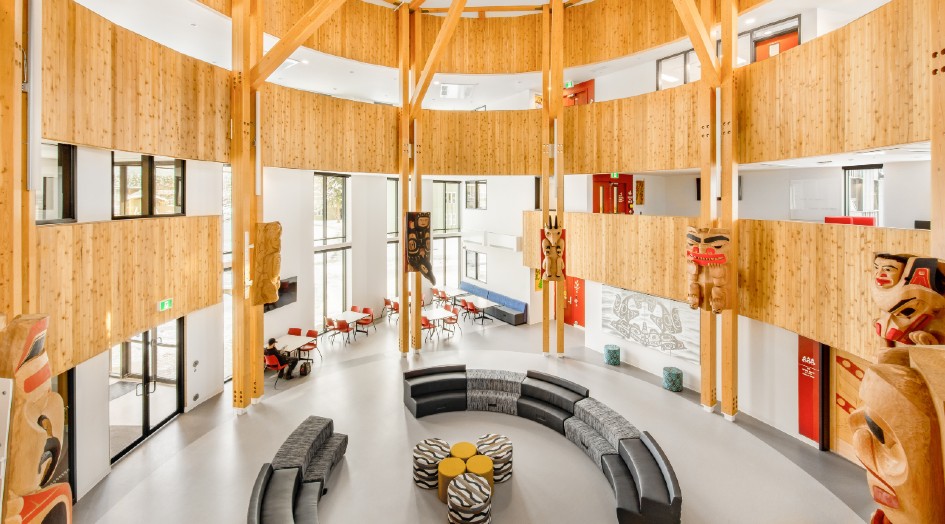
Central celebration space. Photo by Bright Photography.
A safe space for spiritual practice
Coast Mountain College’s First Nation Council identified key cultural spaces to integrate throughout the building. An Elders suite and two suites for visiting families provide accommodation and facilitate the traditional practice of Elders and family supporting students through their education. A cultural room offers a safe space for knowledge sharing and cultural practice, with a carved door and appropriate ventilation for smudging. Elsewhere, a maker space allows students to integrate art and craft into their day-to-day lives.
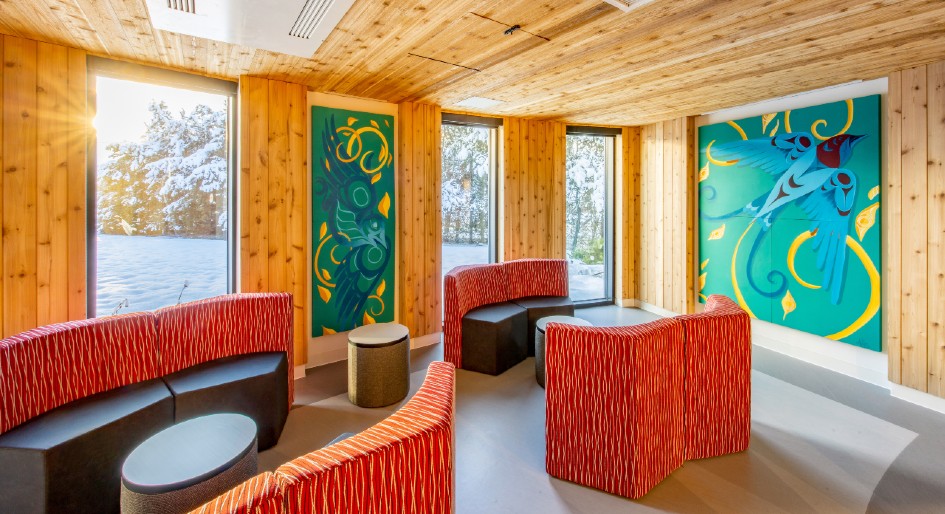
A lounge. Photo by Bright Photography. Art: Panels by Stephanie Anderson, Wet’suwet’en nation & Amanda Hugon, Salish nation.
Strengthening language through co-created signage
To revitalize and strengthen Sm’algyax—the local First Nations language where the building resides—two Tsimshian territory holders and Kitsumkalum Elders translated signage into Sm’algyax.
As some spaces use colonial terms with no direct translation in Sm’algyax, the territory holders had the right to determine translations that were culturally appropriate, recognizing the rich nuances between languages that can make direct translation difficult or impossible. Tsm’syen/Nisga’a fine arts student Shawna Kiesman collaborated with hcma’s communication designers to transform signage iconography into custom formline design.
Energy efficiency and seamless construction
Wii Gyemsiga Siwilaawksat’s housing integrates 36 prefabricated modules. Each one was built off-site to enable faster delivery times. The central structure was site-built, allowing for a unique cultural expression and creating a seamless transition between the modular construction.
The building has met British Columbia Energy Step Code 4, achieving the high energy-efficiency standard through increased insulation, careful attention to detailing, minimizing heat loss, increased level of air-tightness, and triple pane glazing.



